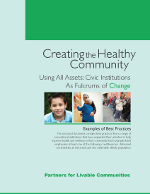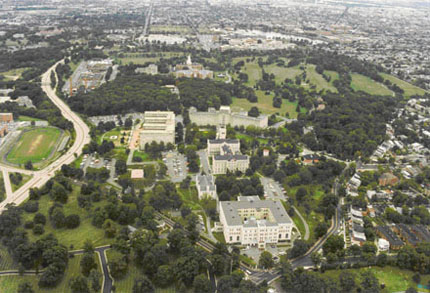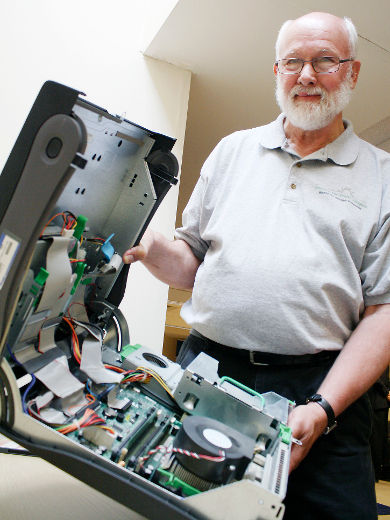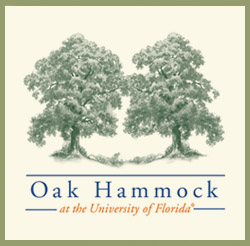
Partners compiled a collection of best practices of traditional community institutions incorporating health and wellness into their agenda and programming to improve community health. The best practices focus on improving the health of at least one of three constituencies: distressed communities, at-risk youth, and the vulnerable elderly.
Examples of institutions include arts and culture organizations, botanical gardens, community development corporations (CDCs), faith-based organizations, libraries, museums, public markets, and zoos.
Click here to download Creating the Healthy Community - Using All Assets: Institutions as Fulcrums of Change
Read more »
Terms:Aging, Community Building, Community Development, Community Engagement, Creating The Healthy Community, Cultural Institutions, Health & Wellness, Healthy Communities, Institutions as Fulcrums of Change , Intergenerational, Libraries, Program Areas, Public Health

The U.S. Armed Forces Retirement Home in Washington, D.C., commonly referred to as the ‘Soldiers’ Home,’ is one of the country’s oldest veterans’ retirement homes and certainly one of the most beautiful. Located on a 273-acre campus in Northwest D.C., the Home’s green pastures and tranquil lakes sit in stark contrast to the developed neighborhoods of the surrounding community. Since the home opened in 1851, the retirement community has been home to thousands of retired elderly and disabled veterans in the Washington area.
Read more »

Project Phoenix is an intergenerational program based in Wellend, Ontario, just outside of Niagara, run jointly by the nonprofits Seniors for Youth Niagara and Youth Resources Niagara. The program aims to close the gap between seniors and youth for the purpose of improving the community by giving senior volunteers a chance to interact and share their knowledge and experience with at-risk youth in the area.
Read more »
As the baby-boomer population all reach the age of retirement, many older individuals are going to be forced into assisted living facilities. This article featured on PlaceMakers by Ben Brown highlights the ElderSpirit Community in Abingdon, VA, which on a relatively small budget, has created a community for older individuals that emphasizes people, skills, and needs.
"Among the Big Issues awaiting communities after we shake off the post-recession blues is what to do about demography. Particularly the part about America’s aging population.
The first-borns among the 76-million-strong Baby Boomer generation reached 65 in 2011. And over the next three decades, the geezer slice of the population pie will swell to 20 percent, compared to a little more than 13 percent in 2010. Take a look at the chart below, compiled from Census projections and pulled from the informative Alliance for Aging site.
That’s more than 88 million folks 65-plus, with the fastest growing cohorts the “oldest-old” segments of 80-plus.
I have a special interest in this topic, given that I’m among those leading-edge Boomers who have reconfigured commerce and culture to suit our tastes over the last half-century. It’s been a great run.
By now, just about everybody not invited to our long-running generational fiesta is tired of indulging Boomer fantasies. Sorry. Since we’re still running lots of stuff and still hoarding most of America’s financial assets, there’s more to come. Currently, we’re in the middle of one of our periodic – and probably our last – reality denial exercises. This is the one where we’re pretending Big Pharma, robots, electric cars and Dr. Oz will extend our playtime into infinity. You know, “60 is the new 40.” Unlike previous Boomer reality ducks, however, this one is going to be tough to buy or lie our way out of....."
Read More.
Read more »
 photo credit Dances for A Variable Population photo credit Dances for A Variable Population
Dancers dressed in vibrant red move across The High Line, an elevated historic rail line turned public park in Manhattan’s West Side, enticing passersby to stop and look at the beautiful performance. Half of the dancers seem to be young, fit, and professionally trained. The other half move more slowly, some dancing in place, and some sitting. In fact, they are all older adults.
Dance artist Naomi Goldberg Haas founded and directs Dances For A Variable Population (DVP), a dance company whose goal is to erase the borders between dancers and audience through its unique choreography and dance company, comprising adults 24 to 82 years of age. Haas enjoys site-specific dance performances, which place the audience and dancers of all ages in the same space. She says, “[In these] new conceptions of shared space, we celebrate how dance can be a vehicle for wellness and expression for seniors, persons with disabilities, youth, and regular folk; how dance can change from an ‘under-exposed’ art form in a community to become an active tool for community participation, enthusiasm, and social interaction.”
Read more »
Recess for seniors may sound unusual, but it is just one of many volunteer roles that the Rochester School District’s Office of Extended School Programs has developed to increase community involvement in its elementary schools. The Rochester School Department defines as its goal the enhanced achievement and academic success of students who participate in extended-school programs. Volunteers play a key role in support of these programs. The Office organizes enrichment programs by sharing resources, creating partnerships with businesses and community organizations, and involving parents.
These programs have proven to be a boon to both students and volunteers, many of whom are older adults. Intergenerational activities benefit senior volunteers, who take pleasure in giving back to their communities and participating in a structured social environment. They often exult in the joy of working with children.
Read more »
 photo credit Northwood Park Historical Society photo credit Northwood Park Historical Society
The vision of the Norwood Park Historical Society (NPHS) is to be “recognized as a leader, educator, advocate, and resource” in the community of Norwood Park that “values and preserves its historic character and is acknowledged as an area of historical importance to the city of Chicago and the region.” To reach out to older adults, the NPHS launched Voices of Norwood Park, a personal-history project designed to educate older adults about methods for recording their histories and for collecting written and oral histories of their lives and times in Norwood Park.
Norwood Park is one of the oldest, most distinctive, and historically important neighborhoods in the Chicago metropolitan area. NPHS was formed in 1973 to preserve Norwood Park’s history and promote community awareness. The Society has transformed the oldest house in Chicago, which serves as its offices, into a multipurpose community center with a museum and a café. Its museum focuses on Chicago’s far-northwest side and has a growing collection of historical artifacts and research materials.
Read more »
Terms:2012, Aging, Aging in Place, AIP Best Practice, Chicago, IL, City Leaders Institute on Aging in Place, Community Engagement, Cultural Institutions, Heritage, Historic Preservation, Intergenerational
 photo credit Phoenix New Times photo credit Phoenix New Times
The Arizona Science Center has long engaged adult volunteers age 50+ as docents, and in
other conventional volunteer roles, but only recently the Center began to tap volunteers’ science and technology skills to enhance its programs. Jan Stonebraker, the Science Center volunteer coordinator of four years, entered the position as the Center launched a large travelling exhibition titled Body Worlds 3, an exploration of biology and anatomy.
Stonebraker identified knowledgeable volunteers to help staff the exhibition. At around the same time, the Virginia G. Piper Charitable Trust funded a leadership grant program, through the National Council on Aging (NCOA), to engage adult volunteers age 50+ in leadership roles. The Science Center development staff and Stonebraker designed a program that would qualify for a grant. Stonebraker found that many volunteers were retired mechanical and electrical engineers, information technology specialists, and science teachers who wanted to help the Center. It made eminent sense to use their skills to enhance educational programs.
Read more »
Terms:2012, Aging, Aging in Place, AIP Best Practice, Arizona, City Leaders Institute on Aging in Place, Community Engagement, Education, Intergenerational, Jobs, Life-Long Learning, Museums, Public-Private Partnerships
 photo credit Massachusetts Cultural Council photo credit Massachusetts Cultural Council
The Elder Arts Initiative joined artists, government, and service providers to engage older adults in the artistic process. Participants in the Elder Arts Initiative learned interviewing skills and techniques employed in the creative process, and had the opportunity to take part in a mentorship or pilot project of their own. Though considerable funding was curtailed in 2002, the Massachusetts Cultural Council (MCC) continues to support local arts programs in the state through grants.
The Initiative began in 1996, when the Cultural Council, the Massachusetts Extended Care Federation (an association of nursing homes), the Executive Office for Elder Affairs, and the State's Council on Aging held a series of meetings about older adults and the arts. The Cultural Council then launched the Initiative in 1997.
The National Endowment for the Arts provided funding for the Initiative through its Challenge America Program Initiative and "Artists and Communities: America Creates for the Millennium Program." For older adults, the benefits of the Initiative included social interaction, an enhanced sense of purpose, a window for introspection, and improvement in physical health. In addition, the Initiative enabled older adults to communicate their wisdom and experience to younger generations.
Read more »
 photo credit Intergeneration Orchestra of Omaha photo credit Intergeneration Orchestra of Omaha
Symbolized by a rose in full bloom and a rose bud, the Intergeneration Orchestra of Omaha (IGO Omaha) joins older, experienced musicians with young musicians, using a love of music to bridge generation gaps. The Orchestra explains that, “The rose in full bloom signifies the lifetime of experience the older musicians bring to the group, while the rosebud represents the emerging talents of our younger artists.” This intergenerational program is a win-win for all involved; the young gain the opportunity to develop their skills, while older participants are able to play the music they love well past the age of retirement. Perhaps more significantly, both young and old find support and friendship as they pursue musical excellence.
With the goal of joining two distinct generations “through the universal language of music,” the IGO of Omaha was started by Chris Gillette, current project director of the Orchestra and the director of the Community Services Division of the Eastern Nebraska Office on Aging (ENOA), and former co-worker Cora Lee Bell. The Orchestra was initially funded by a grant from the Peter Kiewit Foundation, but has since been supported by numerous other grants, donations, memberships, fundraisers, and performance fees, and a sponsorship from ENOA. The Orchestra is run by an elected board of directors, which includes two younger and two older musicians.
Read more »
Terms:2012, Aging, Aging in Place, AIP Best Practice, Arts & Culture, City Leaders Institute on Aging in Place, Community Engagement, Cultural Institutions, Intergenerational, Life-Long Learning, Youth
Housed in a stunning building designed by Frank Lloyd Wright, ASU Gammage at Arizona State University, one of the largest university-based theaters in the world, has been broadening its audience for many years. Its outreach extends to both immigrant and older adult audiences. Widely recognized for its work in Phoenix, ASU Gammage’s commitment becomes evident in the role played by one of its staff members: Michael Reed, the senior director of Cultural Participation and Programming, is responsible for developing and overseeing an astonishing array of performances, including explorations of theater arts for all ages, and programs highlighting the arts of various cultures.
The commitment to accommodating older adults, for example, was demonstrated while The Phantom of the Opera was at the theater for a four-week run. To better suit the preferences of older adult audiences, some performances were scheduled as matinees. Reed also explains that the house staff is very experienced in working with older adults and those who are frail or have disabilities. The staff works with ARTability, an Arizona organization that promotes accessibility to the arts for those with disabilities. Before each season begins, the staff reviews issues related to the Americans with Disabilities Act (ADA), though Frank Lloyd Wright’s design, while handsome, has made retrofitting ASU Gammage to meet the requirements of the ADA, and other evolving audience needs, quite difficult.
Read more »
Terms:2012, Aging, Aging in Place, AIP Best Practice, Arizona, Arts & Culture, City Leaders Institute on Aging in Place, Community Engagement, Cultural Institutions, Diversity, Education, Immigration, Intergenerational, Mobility, Youth
 photo credit Oak HammockAs the baby boomers reach retirement age, institutions across the United States will have to find creative solutions to accommodate their burgeoning numbers. Despite this growing need, a retirement community on a college campus might not seem to be a great idea. It’s not difficult to imagine late-night police calls from seniors who think midnight is entirely too late to be playing loud music, or are appalled by the undergraduates who trample the beloved garden of a 90-year old during their late night escapades. But Oak Hammock at the University of Florida, Inc. has created just such an unlikely pairing, a relationship in which university administration, students, senior residents, and other stakeholders have found a lot to like. photo credit Oak HammockAs the baby boomers reach retirement age, institutions across the United States will have to find creative solutions to accommodate their burgeoning numbers. Despite this growing need, a retirement community on a college campus might not seem to be a great idea. It’s not difficult to imagine late-night police calls from seniors who think midnight is entirely too late to be playing loud music, or are appalled by the undergraduates who trample the beloved garden of a 90-year old during their late night escapades. But Oak Hammock at the University of Florida, Inc. has created just such an unlikely pairing, a relationship in which university administration, students, senior residents, and other stakeholders have found a lot to like.
Read more »
Terms:2012, Aging, Aging in Place, AIP Best Practice, Arts & Culture, City Leaders Institute on Aging in Place, Community Engagement, Environment, Florida, Health & Wellness, Housing, Intergenerational, Life-Long Learning, Town-Gown, Youth
 photo credit Project SHINE photo credit Project SHINE
“When I first came to America, I only knew a couple letters. I couldn't communicate with anybody. And I learned about this program and I started (to learn English). I have been here for three years and now I have built a basic vocabulary that I can carry my daily life. It basically helped me to live in America." -Project SHINE participant
In the early 1980s, Nancy Henkin, founder and director of the Intergenerational Center at Temple University, was shocked by the news that loneliness and social isolation led an elderly Asian woman to commit suicide, at a time when it was commonly assumed that older immigrants were part of tight-knit and supportive communities. Henkin realized that older immigrants often struggle with language barriers, changes in customs, and differences in social roles more than their younger counterparts, and began working to establish a program that could support them. Project SHINE was launched in 1985, to reach out and provide aging immigrants with language and cultural resources to help them adapt in their new community.
Read more »
Terms:2012, Aging, Aging in Place, AIP Best Practice, City Leaders Institute on Aging in Place, Community Development, Community Engagement, Education, Faith Community, Families, Health & Wellness, Heritage, Immigration, Intergenerational, Jobs, Life-Long Learning, Multicultural, National, Youth
 Partners for Livable Communities presents a PowerPoint presentation to accompany the 2012 Stories for Change report. This presentation is for community residents, city leaders, arts and cultural institutions, and many more to share the great stories of innovation and creativity featured in the Stories for Change report to begin discussions of reaching out to older adults and immigrants with the community. Partners for Livable Communities presents a PowerPoint presentation to accompany the 2012 Stories for Change report. This presentation is for community residents, city leaders, arts and cultural institutions, and many more to share the great stories of innovation and creativity featured in the Stories for Change report to begin discussions of reaching out to older adults and immigrants with the community.
Read more »
Rarely does the subject of water inspire poetic phrases or passionate dedications. While we may occasionally recognize its importance, this appreciation is usually offset by the size of the water bill at the end of the month. Regardless, I’m going to ask an odd question: have you ever celebrated water? If I got a single “yes” I would be very surprised, for the simple reason that there are few formalized occasions for the public to appreciate water. This year, a multitude of civic and non-profit organizations have teamed up to give individuals the opportunity to celebrate their “love for water” in the annual Rachel Carson Sense of Wonder Contest.
 2012 marks the 40th Anniversary of the Clean Water Act. Although it was originally enacted in 1948, the Act was significantly reorganized and expanded in 1972 to regulate discharges of water pollutants and monitoring water quality standards in the United States. The Annual Rachel Carson Sense of Wonder Contest is honoring this anniversary and renaming itself the “Sense of Water Contest” for 2012. 2012 marks the 40th Anniversary of the Clean Water Act. Although it was originally enacted in 1948, the Act was significantly reorganized and expanded in 1972 to regulate discharges of water pollutants and monitoring water quality standards in the United States. The Annual Rachel Carson Sense of Wonder Contest is honoring this anniversary and renaming itself the “Sense of Water Contest” for 2012.
Read more »
Terms:Aging, Aging in Place, AIP Best Practice, Arts & Culture, Community Building, Community Engagement, Diversity, Environment, Families, Intergenerational, Youth
Oakland, CA
A Senior Theatre Company that uses theatre and storytelling to bridge generation gaps and break down stereotypes about aging.
Read more »
What if your refrigerator gave you breakfast suggestions? Or your bed checked you for health problems while you slept? Our aging population is spurring the creation of a host of friendly household gadgets, including everything from floors that absorb the impact of falls, to mattress pads that assess vital signs and alert health care professionals to any irregularities. Outside the home, technology is in the works to create personalized radio frequency identification cards, which can tell grocery shelves to lower to your eye level or help gym machines adjust to your ability.
The Columbia University Graduate School of Journalism is exploring advances like these, along with the physical and emotional experience of aging, in their project “Brave Old World.”
Read more »
Mount Rainier, MD
A non-profit organization dedicated to the promotion, preservation, education, and development of Latin American art and culture.
Read more »
Terms:Arts & Culture, Community Building, Community Development, Cultural Institutions, Diversity, Education, Intergenerational, International, Multicultural, Washington, DC
New York City, NY
Weekly workshops that bring together a diverse audience of participants in order to promote multi-cultural, intergenerational interaction within the community.
Read more »
Jackson, MS
A former shopping mall that has been converted into a comprehensive, multidisciplinary health care complex.
Read more »
Terms:Aging, Downtown Development, Economic Development, Health & Wellness, Intergenerational, Jackson, MS, Public-Private Partnerships, Social Services, Town-Gown, Urban
|
|